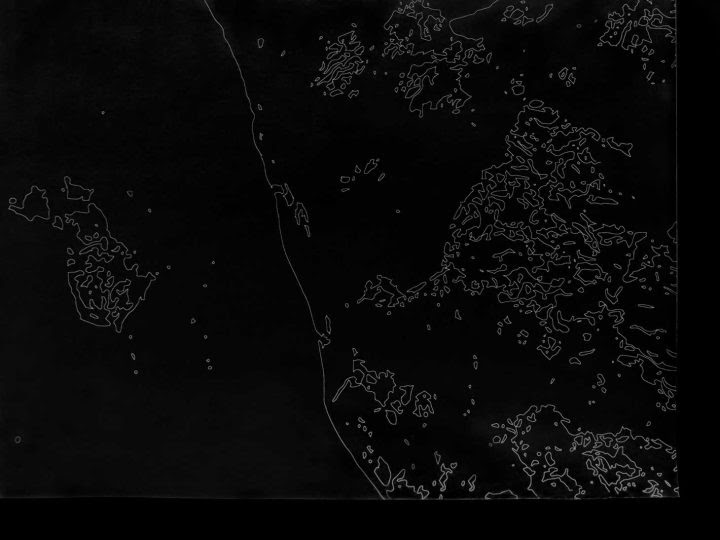Rethinking the Physical Limits of Photography
A dual exhibition of works by Jennifer Brandon and Andréanne Michon destabilizes comfortable perceptions of the photographic medium, its physical limits, and relationship to time.
Jennifer Brandon, “Dispersion II” (2019) (photo by and courtesy of Jennifer Brandon)
A dual exhibition spotlighting the work of Jennifer Brandon and Andréanne Michon presents multiple photo-based projects that destabilize comfortable perceptions of the photographic medium, its physical limits, and relationship to time. Brandon’s adventurous material explorations spur a reconsideration of what we think we see, while Michon’s multimedia projects challenge us to consider earnestly how the world around us is shaped. Colliding affords an opportunity to think of time as a concept both immediate and inconceivably long, and photography as time’s playful yet untrustworthy interpreter.
Jennifer Brandon, “Equivalent I” (2019) (detail) (photo by and courtesy of Jennifer Brandon)
Bay Area-based photographer Jennifer Brandon uses what she calls “humble” materials, which are familiar to photographers or other studio-based artists (aluminum foil, photo mount, and glass cleaner), and renders them unfamiliar. Photography fans may associate her “Equivalent I” (2019) with Alfred Stieglitz’s meditative Equivalentsseries, but it’s not clouds that Brandon captures. Instead, she photographed agitated Windex, capturing froth that bears more than a passing resemblance to the gauzy clouds that Stieglitz captured stretching across the sky over Lake George, NY.
Brandon’s Silverscapes series isolates small sections of aluminum, and more exotic lab-grown silver foil, against a stark white backdrop in a way that suggests birds or other celestial bodies halted in motion. Manipulating materials and the scale at which objects are captured so that viewers may question our perception is one of Brandon’s pursuits. Another calls up notions of sorcery. “I go to great ends to get to a point where materials are doing something, rather than me,” Brandon notes in Sarah M. Miller’s lucid companion exhibition essay. Surrendering her role as a chemical wizard, Brandon’s “Dispersion II and III” (2019) — unique gelatin fiber prints doused with mirror remover — changes daily in the gallery due to environmental exposure.
Andréanne Michon, “n o w h e r e — Fractured 25” (2017-19) (detail) (photo by and courtesy of Andréanne Michon)
Photography’s relationship to time is, at best, ambiguous. Sped up, photographs capture in milliseconds what in real time occurs over hours, months, or years. Slowed down, the photographic or cinematic image appears to arrest the temporal and physical forces that influence everything on earth. Toronto-based artist Andréanne Michon’s work takes up terrestrial activity — volcanic and tectonic movement — through photography, video, sculpture, and printmaking as a potent visual representation of the physical forces that have shaped our environment across a timespan wider than the human mind can comprehend.

Andréanne Michon, “Index 8” (2018) (photo by and courtesy of Andréanne Michon)
Hung in a tight, asymmetrical salon-style grouping, images from Michon’s Index series (2018-19) present rock formations varying in color and texture in extreme close up. Without contextualizing cues to indicate where the images were captured, viewers are faced with harshly beautiful compositions that evidence the planet’s inconceivably slow yet constant evolution. We marvel or tremble at volcanic eruptions that spit rivers of liquid fire onto the land, but how often do we consider stable forms such as rocks, mountains, or slot canyons as evidence of time’s passage?

Andréanne Michon, “Disappearing Landscape 10” (2019) (detail) (photo by and courtesy of Andréanne Michon)
Where Michon’s enigmatic, almost taxonomic visual account of rock formations resist traditional definitions of landscape, her three-dimensional sculptural and print explorations alternately evoke terrestrial volume and its lack. Installed at the center of the gallery, “n o w h e r e — Fractured 25” (2017-19) includes silver gelatin fiber prints turned sculptures that appear to flutter and pull away from the pitch black wall. Marks resembling scarring on rocks that have withstood eons of weather and incremental movement entice visitors to run curious fingers over the surface. We know, of course, that these are not rocks, but their evident tactility and a desire to understand their origin still appeals. Alternately, Michon’s stridently flat “Disappearing Landscapes” (2018-19) suggest topographic maps. By the artist’s hand, these familiar, otherwise authoritative mapping tools fail in their intended purpose to convey information. It is as if the physical forms they report have been pressed into abstract oblivion, the land disappearing before our eyes.

Jennifer Brandon’s Silverscapes (white wall), Andréanne Michon’s “n o w h e r e — Fractured 25″ (black wall) (photo by and courtesy of Andréanne Michon)
On their own, Brandon and Michon’s work easily merit solo exhibitions, but it is through this thoughtful pairing that deep explorations of process, materials, medium, and time come to the fore. Colliding poses a significant challenge for viewers, myself included, who consume visual information at ever demanding Internet speeds. Resisting the urge to move quickly from one object to the next and denying our white-knuckle addiction to information pays off as these abstract forms provide precious relief from the representational. Colliding invites us to slow down, to ponder matters larger and smaller than the day’s demands.
Colliding is on view at SF Camerawork through June 8. The exhibition was organized by Heather Snider, SF Camerawork Executive Director.





